I will be leaving Sussex and The Priory very soon. And if I’m excited about my future life in a different part of England, my lower lip trembles sometimes at the thought of leaving this garden; a garden in which I’ve spent hundreds and hundreds of my days. (By a rough calculation, more than 1500).
I’ve been so busy selling a house here and buying a house in Gloucestershire, that I’ve neglected to show you The Priory during her best time: May and June. But then, as I was walking about the grounds last week, I noticed so many pretty things, so much darn flower that I paused, slapped my forehead and ran for my dusty camera. Here’s a little – mostly rose and clematis – of that Priory June color.
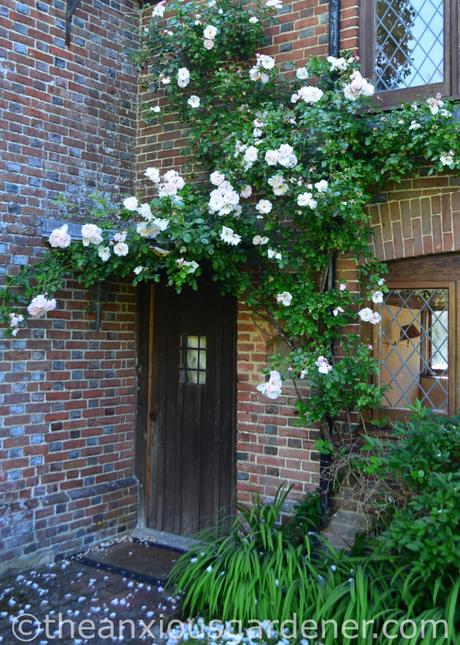
This Rosa ‘New Dawn’ was growing by the front door on the day I started work in 2008. I haven’t done much to it other than train it upwards and along the flat leaded porch roof. I don’t even feed it but, despite neglectful care, it flowers heartily and gives a warm welcome – to non-existent visitors.
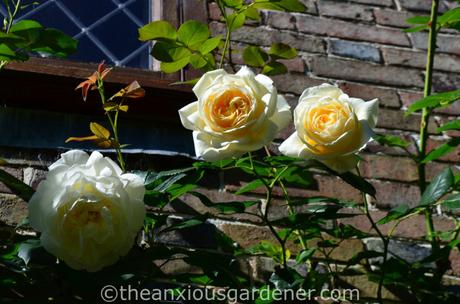
Whereas, Rosa ‘Madame Alfred Carrière’ I did plant. It grows above the kitchen door and window in almost perpetual shade, barely suffers from rust nor black spot and bears heavy, fragrant, repeat blooms. My kind of rose and perfect for this north facing wall.
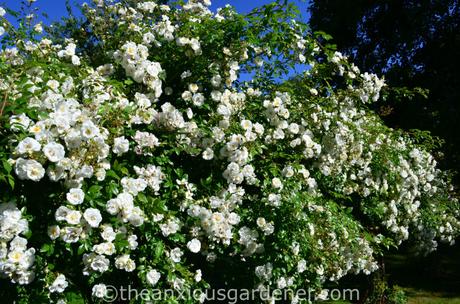
On the rose tunnel, R. ‘Sander’s White‘ is a big fat show off.
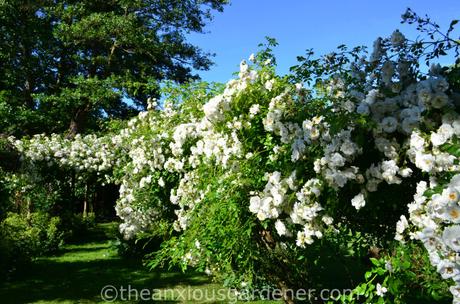
This is not an understated rose. It has a superabundance of blooms with a scent that punches you in the nose – in a playfull way. For a few days in June, it flowers quite delightfully, quite madly.

As you probably know – if you’ve been reading my record of a Sussex garden for a while – I grow several different clematis in amongst the roses on the tunnel. The Sander’s White is a short-lived phenomenon after all.
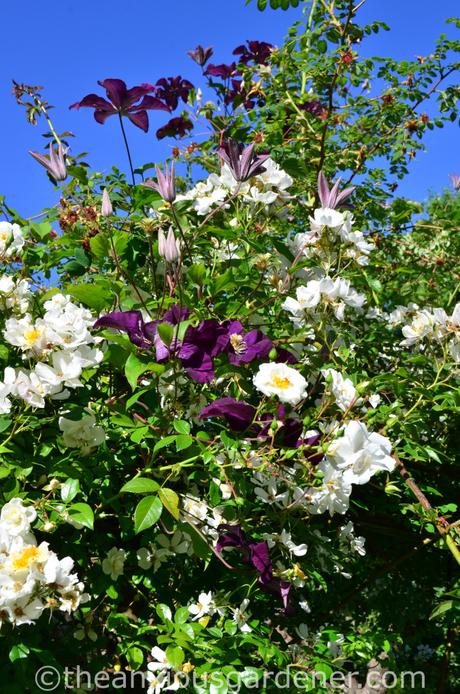
The large flat plates of Clematis ‘Warszawska Nike’ is one of fifteen varieties of clematis here.

Conventional wisdom would have me prune this pruning group 3 clematis* each spring to 6-8 inches above ground level but I’ve learnt that doing so presents beak-level, tender new shoots to hungry pheasant. So, I don’t do that. No. I cut back to a pair of shoots at about 3 or 4 feet – out of reach of pheasant and also beyond concerted slug attack. The clematis grows taller too … with its flowers intertwining amongst the roses rather than staring at my navel.
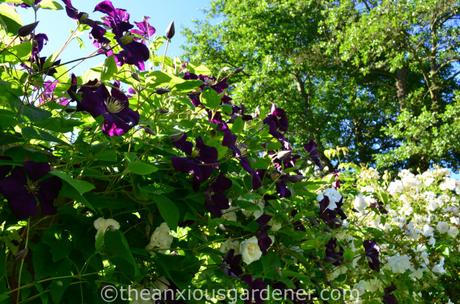
Nearby is Clematis ‘Étoile Violette’ – also pruning group 3. Again, I leave several feet of stem when pruning in spring. If I thwart the attention of pheasant, I provide handy nose-level morsels to deer. Win some …
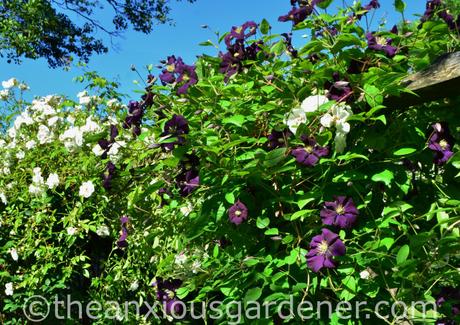
Étoile Violette bears lots of deep, purple flower and eventually scrambles far above the regular attention of deer. This year, the deer damage to trees, shrubs and er, most things actually, has been particularly bad.
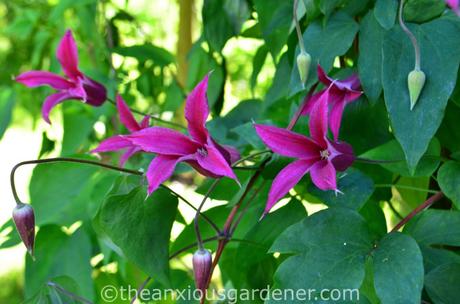
On a shadier tunnel post, is C. ‘Princess Diana’.
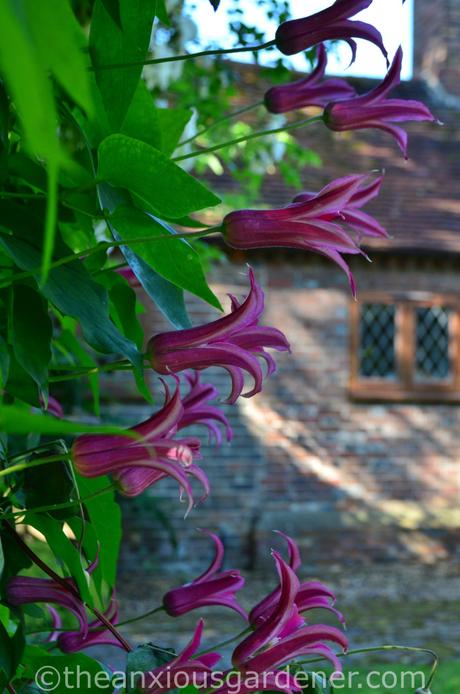
She’s a gaudy pink but I forgive her that – given the beautiful tulip shaped flower. No deer attack on this one yet.
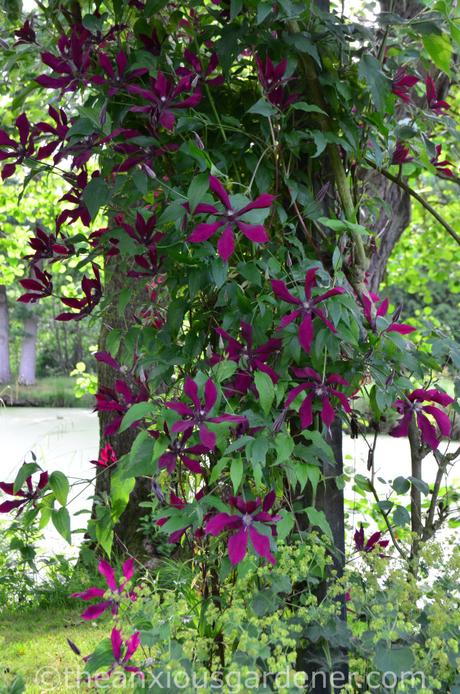
A fairly recent addition is C. ‘Empress Amy Lai’ – another purple,
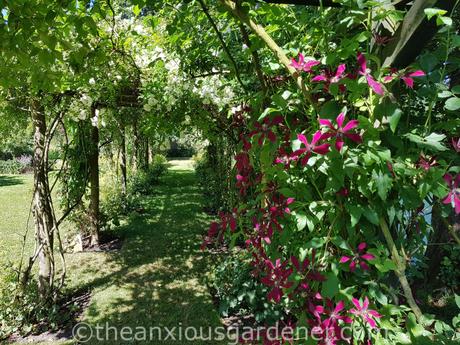
filling the bare stems of climbing roses overhead. C. ‘Empress Amy Lai’ is pruning group 2.
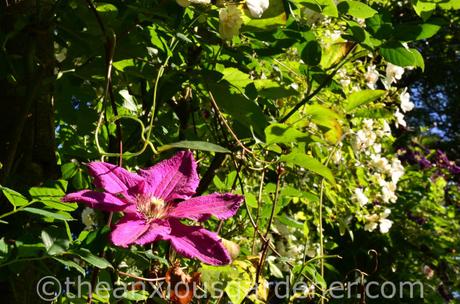
I moved C. ‘Crimson King’ from elsewhere in the garden. It struggled in the long border with competition from so many herbaceous plants and is much happier here. But it ain’t crimson. Group 2.
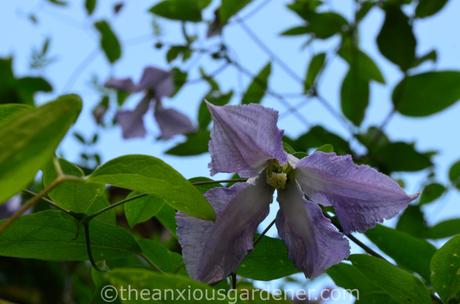
C. ‘Betty Corning’ is a favorite – after seeing it in my mother-in-law’s garden – here growing amongst honeysuckle
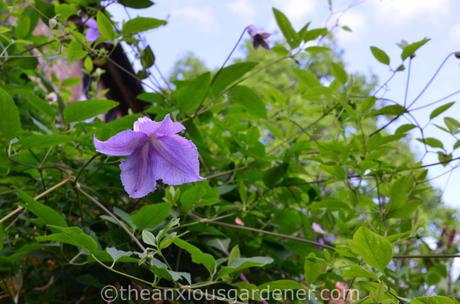
and deftly hiding an old, ugly chain link fence near the house. Also group 3.
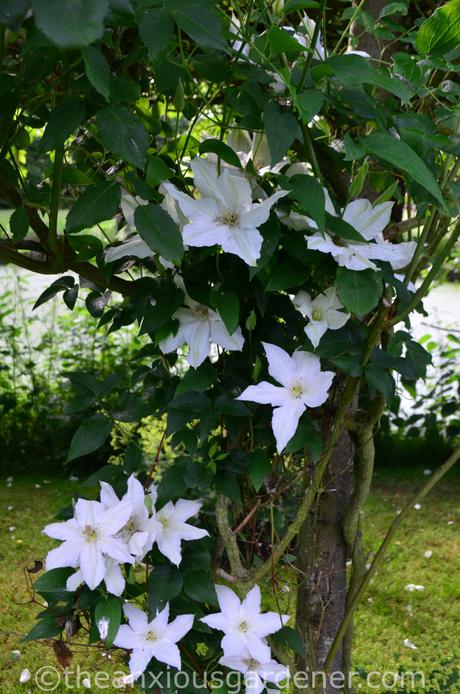
I really like another newbie – Clematis ‘Roko-Kolla’ . It bears large white flowers with subtle green stripes. Another group 3 but you know by now my feelings about pruning back hard.
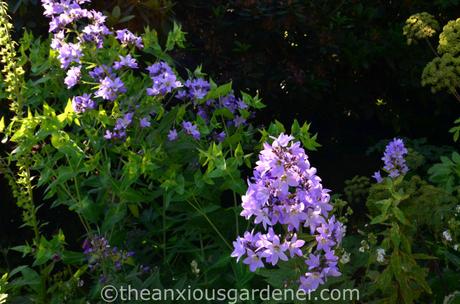
Over in the kidney beds is Campanula lactiflora ‘Prichard’s Variety’ taking over nicely
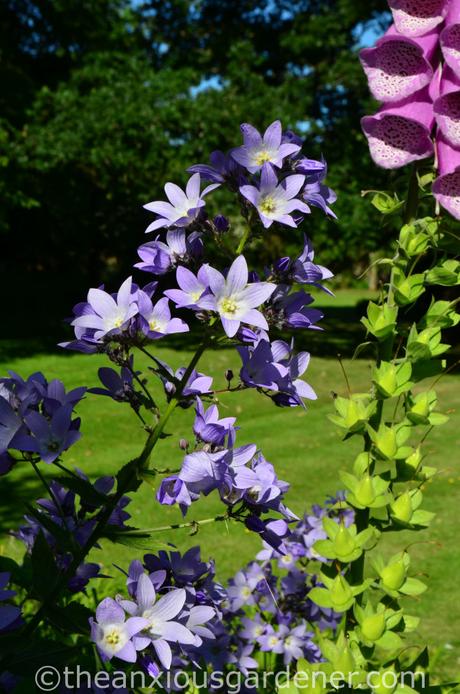
as foxgloves fade away. This is a splendid, large plant with several impressive flower spikes, forming an excellent centrepiece for a June border. At least, that’s what I think.
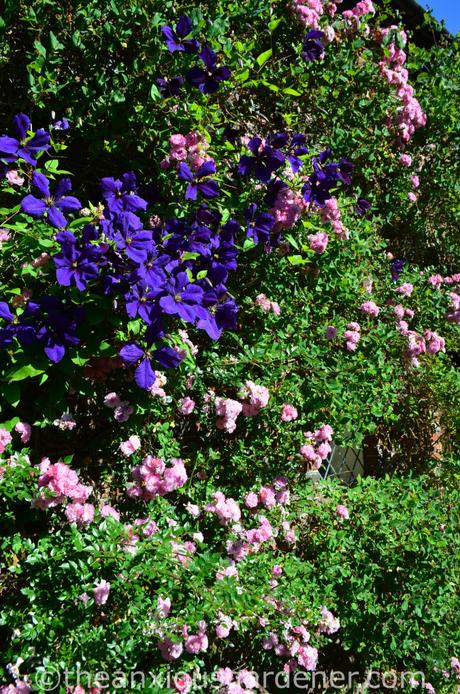
On the east wall of the house is another clematis, Clematis Jackmanii. Growing through a rose (variety unknown), this is the only Priory clematis I didn’t plant.

I keep its roots well shaded (clematis don’t like their roots sun baked) and tuck in shoots that otherwise wave around in the air.
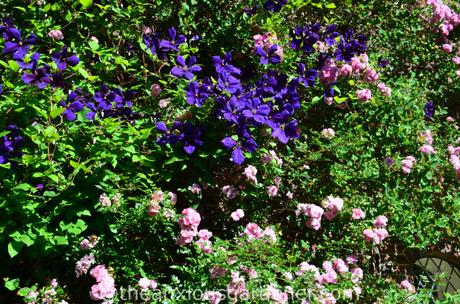
A vigorous plant with a good bold color too. Pruning group 3.
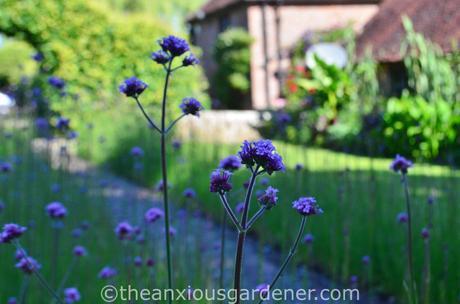
My two twelve meter Verbena bonariensis borders are just coming into flower.
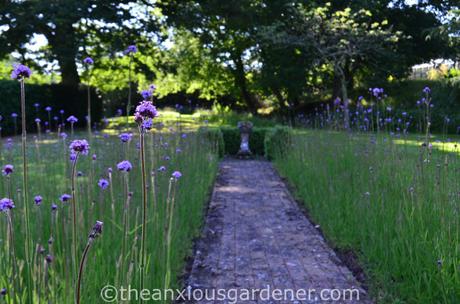
I don’t normally water them but June and July 2018 have been shockingly dry and I’ve relented. I should hate to see this spectacle shrivel and turn yellow before I leave.
It’s a funny job mine. I tend a big garden which hardly anyone ever sees. What’s that about? A week can easily pass without a visitor and now that the house is empty, the owner won’t be coming back. Plants flourish (or don’t), flower (or don’t), and fade away, with only me as witness … with sometimes you too, of course.
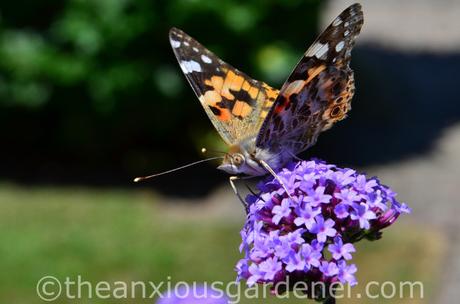
But I do have guests of a sort.
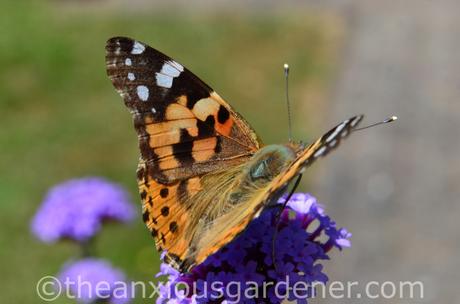
If butterflies, like this Painted Lady, and bees and a host of other insects are attracted to something that I plant, then … well, hell.
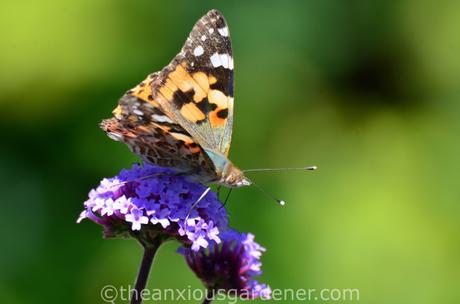
I must be doing something right. Attracting wildlife to The Priory has given me a huge amount of pleasure and satisfaction over the years; so much so that this morning, I watched a doe standing in the shade of the rose tunnel. Rather than frothing with rage at chomped roses and clematis, her lithe beauty filled me with awe.
Just about.
oooOOOooo
* Here’s that note on pruning groups, cribbed from an earlier post on Clematis
- Group 1 – flowers on previous year’s growth and needs hardly any pruning. Tidy up as necessary and reduce in size if it gets too big. If it does need hard cutting back, do so right after flowering.
- Group 2 – flowering stems produced from previous year growth. Cut back weak, damaged stems to a pair of strong buds in late winter. Tie in stems to form a framework in summer.
- Group 3 – flowers on current year’s growth. Cut stems back to a pair of strong buds in early spring, a foot or so above ground level (if you’re pheasant proofed).

